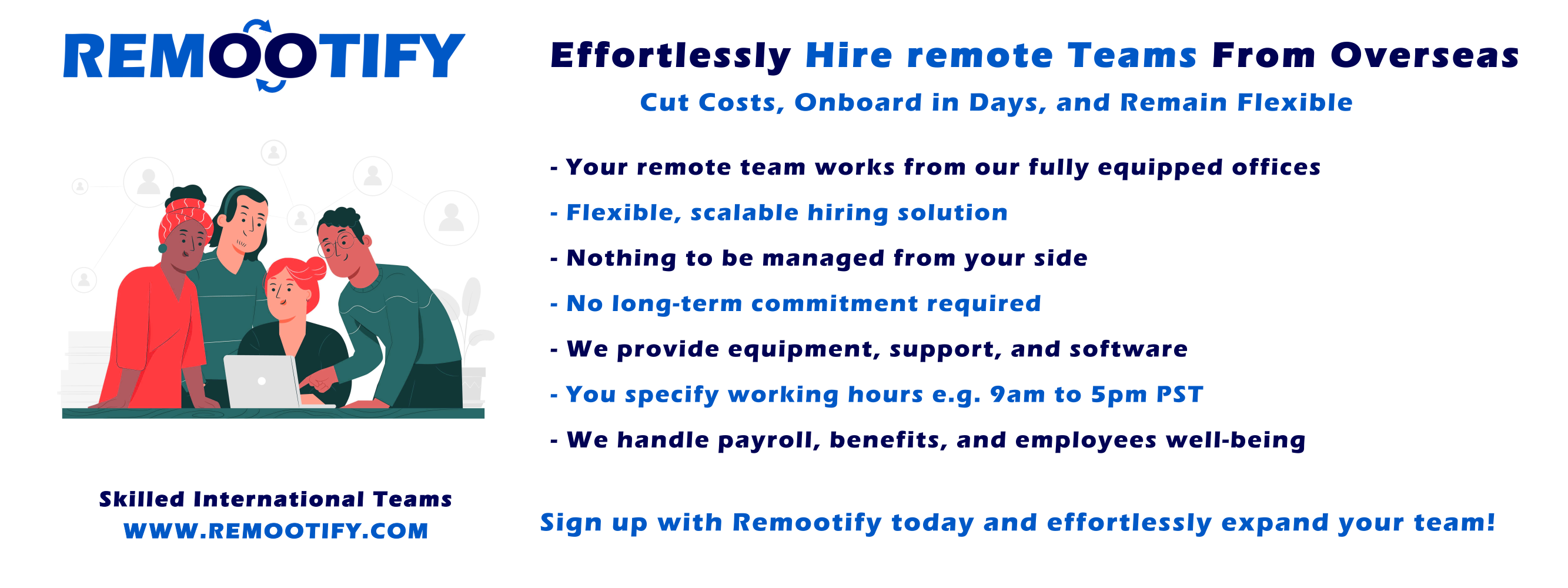Start hiring YOUR REMOTE TEAM, Today!
Enter your information below to start a discussion with one of our team members!

Amid the dynamic terrain of modern business, Information Technology (IT) infrastructure plays an indispensable role.
Organizations increasingly turn to IT infrastructure outsourcing to maintain competitiveness and adapt to evolving markets.
This article delves into the realm of IT infrastructure outsourcing, unveiling its benefits, vital considerations, and best practices.
Whether contemplating outsourcing or refining existing strategies, this guide equips you with essential insights for navigating this intricate landscape effectively.
Key Takeaways
- IT infrastructure outsourcing offers cost savings, access to expertise, scalability, and a sharper focus on core business functions.
- Consider critical factors such as security, vendor selection, SLAs, and compliance when contemplating outsourcing.
- Robust practices, including needs assessment, clear communication, vendor management, contingency planning, and continuous evaluation, enhance outsourcing success.
- A strategic approach to outsourcing can help organizations thrive in a rapidly evolving digital landscape.
Exploring IT Infrastructure Outsourcing
IT infrastructure outsourcing, also known as IT outsourcing or infrastructure as a service (IaaS) outsourcing, is a business practice where organizations contract with third-party service providers to manage and maintain their information technology (IT) infrastructure components.
This includes hardware, software, networking, and various IT services required for day-to-day operations.
IT infrastructure components that companies can outsource include:
- Data Center Services: Hosting equipment in third-party data centers.
- Cloud Services: Using cloud providers for computing resources.
- Managed Hosting: Outsourcing server management.
- Network Services: Managing WAN and LAN.
- Security Services: Cybersecurity protection.
- Backup and Recovery: Data backup and disaster recovery.
- Managed IT Services: Comprehensive IT support.
- End-User Support: Helpdesk and device assistance.
- Application Hosting: Hosting business apps.
- Email and Collaboration: Email and collaboration tools.
- Database Management: Database administration.
- Compliance Auditing: Regulatory compliance checks.
- IT Procurement: Hardware and software purchasing.
- Monitoring and Analytics: 24/7 infrastructure monitoring.
- IT Strategy Consulting: Strategic planning and guidance.
These outsourcing options help companies focus on core business activities while optimizing IT operations.
Why is IT infrastructure important?
Benefits of IT Infrastructure Outsourcing
A. Cost Savings
- Reduction in Capital Expenditures
- Eliminates the need for substantial upfront investments in hardware, software, and data centers.
- Frees up capital for critical business initiatives, such as research and development or marketing.
- Economies of Scale
- Leveraging the provider’s larger client base leads to cost efficiencies.
- Reduced per-unit costs for services like hosting, maintenance, and software licenses.
B. Access to Expertise
- Leveraging Specialized Skills
- Outsourcing partners possess specialized skills in managing complex IT infrastructure components.
- Expertise in areas like network security, data management, and cloud computing.
- Staying Up-to-Date with Technological Advancements
- Outsourcing providers stay current with the latest technological trends and advancements.
- Ensures that your infrastructure benefits from the most up-to-date tools and practices.
C. Scalability and Flexibility
- Easy Expansion or Downsizing of Resources
- Ability to scale IT infrastructure up or down to meet changing demands.
- Valuable in industries with seasonal fluctuations or variable workloads.
- Adaptation to Changing Business Needs
- Flexibility to align infrastructure with shifting business priorities and strategies.
- Quick adjustments to accommodate new product launches, market entries, or operational pivots.
D. Enhanced Focus on Core Competencies
- Shifting Resources Towards Strategic Initiatives
- Offloading IT infrastructure management allows the redirection of internal resources, including talent and time, to core business functions.
- Focus on strategic initiatives fosters innovation, improved customer experiences, and increased market competitiveness.
- Improved Efficiency and Productivity
- Reduced distractions from IT troubleshooting and maintenance for employees.
- Increased productivity as employees concentrate on tasks directly related to the organization’s mission and goals.
Considerations to Assess Before Outsourcing IT Infrastructure
Security and Data Privacy
- Data Protection Regulations
- Understanding the specific data protection laws applicable to your industry and geography (e.g., GDPR, HIPAA, CCPA).
- Ensuring that the outsourcing arrangement complies with these regulations, including data transfer and storage.
- Identifying the types of sensitive data that will be handled by the outsourcing partner (e.g., customer data, financial data, healthcare records).
- Vendor’s Security Protocols
- Evaluating the vendor’s security measures and practices, including encryption, access controls, and vulnerability management.
- Inquiring about their incident response and data breach notification procedures.
- Assessing the physical security of data centers or facilities where your data may be stored.
Vendor Selection
- Evaluating Potential Partners
- Conducting a thorough assessment of potential outsourcing partners, considering factors such as experience, capabilities, and resources.
- Checking references from other clients who have used the vendor’s services.
- Evaluating the vendor’s financial stability and long-term viability.
- Vendor Reputation and Track Record
- Researching the vendor’s reputation within the industry, including online reviews, testimonials, and case studies.
- Examining the vendor’s track record with past clients, looking for successful partnerships and any history of disputes or performance issues.
- Investigating any legal or regulatory actions against the vendor.
Service Level Agreements (SLAs)
- Defining Performance Expectations
- Clearly specifying performance metrics and expectations in the SLA, such as uptime, response times, and resolution times.
- Establishing key performance indicators (KPIs) to measure the vendor’s performance over time.
- Ensuring that SLAs align with your organization’s business objectives.
- Penalties for Non-Compliance
- Outlining penalties or consequences for the vendor in case of SLA breaches, including financial penalties or contract termination clauses.
- Defining the process for dispute resolution and conflict escalation related to SLA violations.
- Ensuring that SLAs are regularly reviewed and updated as business needs evolve.
Compliance and Legal Considerations
- Ensuring Adherence to Industry Regulations
- Verifying that the outsourcing partner has a clear understanding of and commitment to compliance with industry-specific regulations.
- Collaborating with legal and compliance teams to ensure that the outsourcing arrangement meets all necessary regulatory requirements.
- Legal Obligations and Contracts
- Drafting comprehensive contracts that cover all aspects of the outsourcing relationship, including data handling, intellectual property, termination clauses, and dispute resolution.
- Ensuring that the contract clearly defines the roles, responsibilities, and liabilities of both parties.
- Regularly reviewing and updating contracts to adapt to changes in regulations or business needs.
Best Practices in IT Infrastructure Outsourcing
A. Comprehensive Needs Assessment
- Understanding Current Infrastructure
- Conduct a thorough assessment of your existing IT infrastructure, including hardware, software, network, and security.
- Identify strengths, weaknesses, bottlenecks, and areas requiring improvement.
- Identifying Outsourcing Opportunities
- Determine which aspects of your IT infrastructure are suitable for outsourcing based on factors like complexity, cost, and core business relevance.
- Prioritize outsourcing opportunities based on strategic objectives.
B. Clear Communication
- Establishing Effective Channels
- Establish clear lines of communication between your organization and the outsourcing partner.
- Define communication protocols, escalation paths, and points of contact to ensure quick issue resolution.
- Regular Updates and Reporting
- Implement regular reporting mechanisms to monitor the outsourcing arrangement’s performance.
- Set up periodic meetings and reports to discuss progress, challenges, and opportunities for improvement.
C. Robust Vendor Management
- Monitoring Vendor Performance
- Continuously assess the outsourcing partner’s performance against agreed-upon Service Level Agreements (SLAs) and Key Performance Indicators (KPIs).
- Track metrics related to uptime, response times, and issue resolution.
- Resolving Issues and Conflicts
- Develop a clear protocol for addressing issues, disputes, and conflicts that may arise during the outsourcing engagement.
- Establish a framework for collaborative problem-solving and conflict resolution.
D. Contingency Planning
- Preparing for Unforeseen Disruptions
- Develop a comprehensive contingency plan to address potential disruptions, such as natural disasters, cyberattacks, or vendor failures.
- Ensure that your business can continue operations with minimal downtime in case of such events.
- Data Backup and Recovery Strategies
- Implement robust data backup and recovery strategies to safeguard critical information.
- Regularly test backup and recovery procedures to verify their effectiveness.
E. Continuous Evaluation and Improvement
- Periodic Reviews and Audits
- Conduct regular reviews and audits of the outsourcing arrangement to assess its alignment with business objectives.
- Evaluate whether the outsourcing partner continues to meet your organization’s evolving needs.
- Incorporating Feedback for Optimization
- Gather feedback from both your internal stakeholders and the outsourcing partner.
- Use feedback to identify areas for improvement and optimization, making necessary adjustments to enhance the outsourcing relationship over time.
—
Conclusion
In summary, IT infrastructure outsourcing offers substantial benefits but also necessitates careful considerations and adherence to best practices.
By aligning your organization’s needs with these key principles, you can harness the advantages of outsourcing while ensuring a secure and effective partnership with your service providers.
Ultimately, IT infrastructure outsourcing has the potential to elevate your organization’s competitiveness, efficiency, and adaptability in today’s dynamic business landscape.
—
FAQs
What is IT infrastructure outsourcing?
IT infrastructure outsourcing is the practice of delegating the management and operation of an organization’s IT infrastructure components, such as servers, networks, data centers, and cloud services, to a third-party service provider.
What are the key benefits of IT infrastructure outsourcing?
IT infrastructure outsourcing offers benefits including cost savings, access to specialized expertise, scalability, flexibility, and the ability to focus on core business activities.
What are the best practices for successful IT infrastructure outsourcing?
successful IT infrastructure outsourcing includes conducting a comprehensive needs assessment, establishing clear communication channels, robust vendor management, contingency planning, and continuous evaluation and improvement of the outsourcing arrangement.
How can I choose the right outsourcing vendor?
Choose a vendor for successful IT infrastructure outsourcing based on their experience, reputation, track record, financial stability, and alignment with your organization’s goals and values. References and client testimonials can also help in the selection process.





